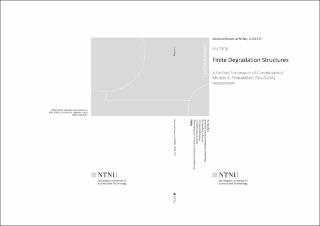| dc.description.abstract | This PhD thesis presents a new modeling framework, called finite degradation structures (FDSs), which can be used as a unified framework of combinatorial models in probabilistic risk/safety assessment.
The so-called combinatorial models refer to those models where the behavior of the system is described as the combination of behaviors of its components. The Boolean combinatorial models have been well mastered by practitioners, such asfault trees, reliability block diagrams and their alternatives. However, when the state of component/system becomes multi-valued, such Boolean models become less applicable. Although more powerful modeling formalisms exist, e.g. Markov chains, Petri nets and guarded transition systems, their computational complexity increases dramatically when leaving the combinatorial realm.
A good compromise is to stay in the combinatorial realm while allow the state of component/system to be multi-valued. This provides the original motivation of this PhD thesis.
Technically, the modeling framework proposed this thesis extends formally all the concepts defined in fault tree analysis from Boolean systems into multistate systems.
The most highlighted part of this work is the use of partially ordered set as state space of multistate component/system. Thanks to this partial order, we are able to define minimal cut/path sets for multistate systems. In our framework, the notion of minimal cutsets is covered by the notion of minimal (degraded) scenarios, which characterizes the minimal paths that the system degrades from an operation state into an undesired state, and the notion of minimal path sets is covered by the notion of maximal (degraded) scenarios, which characterizes the maximal ability that the system remains in a good state. The probabilistic indicators are also included in the proposed modeling framework, e.g. state probabilities, conditional probabilities, sensitivity factors, etc.
The models built on the framework of FDSs are called finite degradation models (FDMs). FDMs generalize both the syntax and the semantics of fault trees to multistate cases. The decision diagrams are used to implement the required calculation of scenarios and probabilistic indicators of FDMs. We adjusted the data structure and the algorithms that have been applied on binary decision diagrams to fit FDMs. Moreover, we also developed a software to realize the computerized modeling and assessment of FDMs. As experimental results, we show the full analysis of a safety instrumented system made of sensors, logic solvers and valves and a simple train control system made of hot-standby subsystems. | en_US |
